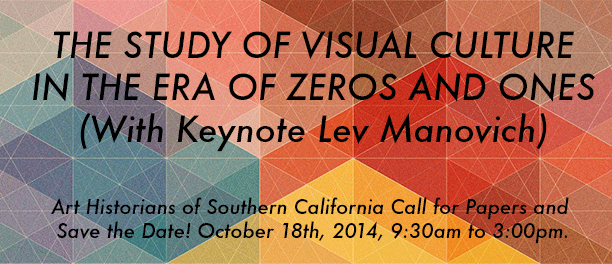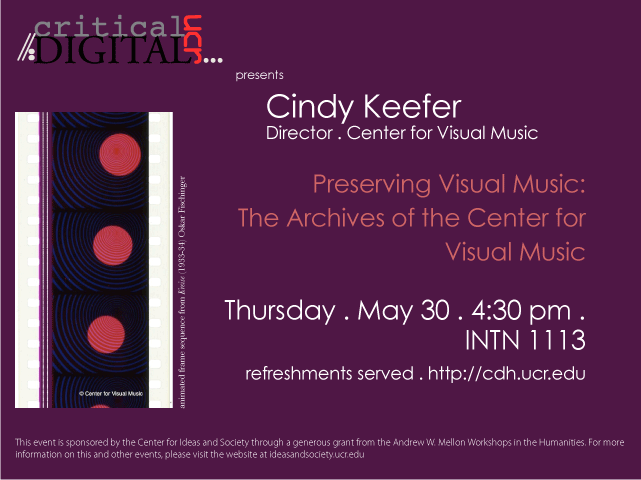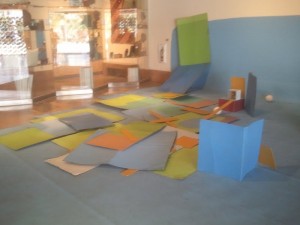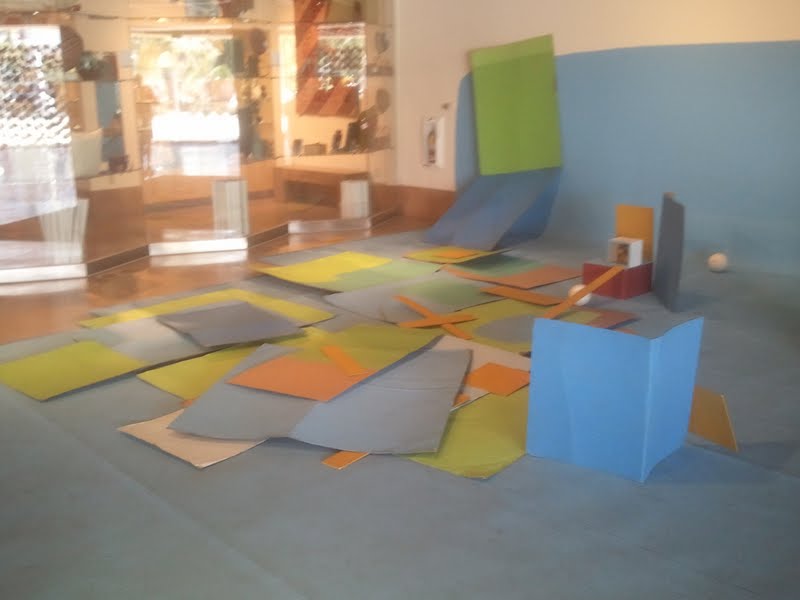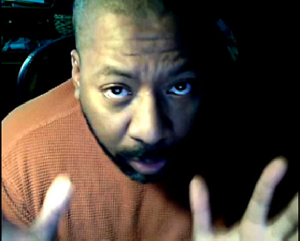Posts from the ‘visual culture’ Category
 Scalar @ ANVC (Alliance for Networking and Visual Culture at USC):
Scalar @ ANVC (Alliance for Networking and Visual Culture at USC):
http://scalar.usc.edu/learning_scalar/webinar-schedule/
Join us for upcoming webinars.
To follow up on our recent Beta release, the Scalar development team will be offering a series of free online webinars this spring and summer.
Our “Introduction to Scalar” webinars will cover basic features of the platform: a review of existing Scalar books and a hands-on introduction to paths, tags, annotations and importing media. Our “Intermediate Scalar” webinars will delve into more advanced topics including the effective use of visualizations, annotating with media and a primer on customizing appearances in Scalar.
Our summer schedule includes the remaining dates:
Intermediate Scalar: July 31, 4-6pm (PST)
Our fall schedule includes six dates:
Introduction to Scalar: August 21, 10am-12pm (PST)
Intermediate Scalar: September 11, 10am-12pm (PST)
Introduction to Scalar: September 25, 4pm-6pm (PST)
Intermediate Scalar: October 9, 4pm-6pm (PST)
Introduction to Scalar: October 30, 10am-12pm (PST)
Intermediate Scalar: November 20, 10am-12pm (PST)
Spaces are limited, so sign up now!
To register for the online webinars, please visit our registration page.
Art Historians of Southern California: http://www.arthistsocal.org/
The tele-electronic digital world is transforming the ways we teach, the types of research we pursue, the subjects we teach about, the methodologies we employ, as well as how we archive and preserve. The Getty has pledge to spend millions on digital tools and USC used its 1.9 million Mellon Grant for Digital Humanities to announce a larger pledge for the University to spend a billion in the next ten years on digital knowledge and informatics. Institutional leverage and enticement with monetary support is sure to create disruption and change for academics. What does this mean for scholars and professionals and how is it going to affect our disciplines? The College Art Association published their Samuel Kress Foundation study on Changing Research in Art History in their May 7th newsletter which highlighted the need for academics of visual culture to respond to the changing needs of the discipline.
This symposium seeks submissions which engage and theorize the ways the study of art history and visual culture are changing and the ways scholars are adapting and innovating to meet these new challenges and opportunities. We encourage inter-disciplinary, trans-disciplinary, cross-disciplinary and uni-disciplinary approaches. Diverse topics are welcome and we imagine receiving proposals on: digital pedagogy, archival practices, digital humanities, database as research, visual scholarship, virtual humanities, digital/virtual/database art among others.
250 Word abstracts should be submitted to meyer_walter@smc.edu & arthistsocal@gmail.com by August 15th. Participants will be notified by September 1st.
The conference will take place on Saturday, October 18th at Santa Monica College. Lev Manovich, pioneer in theorizing cultural analytics and new media history, will be the keynote speaker.
Cindy Keefer, Archivist, Curator & Director . Center for Visual Music
Preserving Visual Music : The Archives of the Center for Visual Music
THURSDAY . May 30 . 4:30 PM . INTN 1113 . Refreshments served .
Cindy Keefer, Director of the Center for Visual Music Los Angeles, will discuss and screen work by pioneers of kinetic art, abstract animation and pre-digital cinema from CVM’s archives. CVM is a Los Angeles archive dedicated to visual music, experimental animation and abstract media. CVM preserves and promotes films by Oskar Fischinger, Jordan Belson, Charles Dockum, Mary Ellen Bute, Jules Engel, Harry Smith and others, as well as contemporary artists. Keefer will screen work from CVM’s archives by Fischinger and Belson, plus Dockum’s Mobilcolor Projections, Bute’s Abstronics (an early oscilloscope film), a short Bute documentary, and more. She will also discuss Belson’s now legendary 1950s Vortex Concerts, CVM’s work with the Fischinger legacy, current preservation work, and Raumlichtkunst, the new HD 3-screen reconstruction of Fischinger’s 1920s multiple-projector performances, recently exhibited at the Whitney Museum, the Tate Modern, and scheduled for exhibition at the Palais de Tokyo in Paris in summer 2013.
This is the last event CDH will host for the 2012-2013 season. Please join us for this exciting presentation.
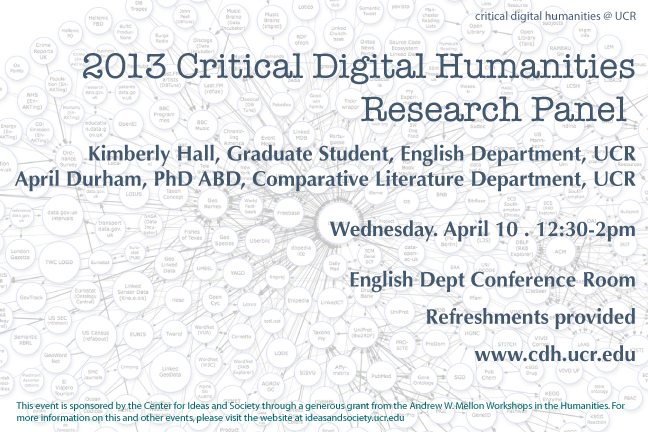 The Critical Digital Humanities presents a CDH research panel with presentations by April Durham and Kimberly Hall. They will present drafts of recent research in digital humanities for discussion and comment.
The Critical Digital Humanities presents a CDH research panel with presentations by April Durham and Kimberly Hall. They will present drafts of recent research in digital humanities for discussion and comment.
Wednesday . April 10 . 12:30 – 2
English Department Conference Room
Refreshments will be served.
April Durham . 17 August 2012
Long Beach is about 20 minutes southwest of the crumbly LA neighborhood where I am spending a sticky-baked summer. I am too tired to drive and Pam prefers to pilot anyway. It’s already needle hot when we leave at 10:23 am. The 110 to the 5 to the 60 to the 710. Aquarium exit to Broadway to Alamitos. The parking lot is mostly empty and (finally) a sea breeze teases us toward the door. The space is so professional, so institutionally proper, with excellent air conditioning, gleaming floors, and very quietly polite security guards. The museum avoids the obvious tropes of Latino-ism, tropical frescoes, colorful tile, dense installation. Instead, minimal institutional space sanctions resistance, creating a strange, almost discomfiting celebration the ways in which its constituency creatively reflects on its experience of the world: a globalized, not-particularly-supportive, often-exploitative world.
Why interactivity? The term implies, these days, a high level of technological
interface, a mediating of the “natural” world by the tools of the cyber terrain. But there are only two pieces with an overtly technological structure: Deep Thought V.2, by Dream Addictive, brings to mind boardwalk fortune telling machines, where touching bolt-like “sensors” connect the traveller to a machine that renders thoughts as biofeedback, eventually spitting out a slip of paper with a Spanish interpretation of the imagination. The other involves sitting inside a little oval hut made from egg cartons and waving hands in front of sensors that emit the sounds of the Tijuana streets. Neither of these pieces functions with the slick, fault-proof necessity of the digital interface though. The sense is that they repeat where they should progress or they reset because the physical touch is too tenuous, issuing faults or making frailty and apparatic vulnerability transparent to that of the “natural” human. Fear of too much interface drives the interaction with these works more than a streamlining of the meat-to-machine we’ve grown to expect à la Sleep Dealer.
An air bladder made from pages of An Introduction to Psychoanalysis and  other books by Freud that the viewer can enter, a candy-finish painting the viewer can touch, and a wall of plastic funerary flowers to which the viewer can add. Only uncertainly interactive, these works seem shy and tentative, failing to invite the masterful engagement humans are used to exercising with their digital partners (AKA computers or games). Appearing as traditional sculptures, the viewer hesitates to touch. The guards stand by looking pointedly to see if you will touch, in fact. But beautifully trained, they kindly, gently encourage, lifting edges, coax the shedding of various bits of clothing, soothingly offer instructions on precisely how to interact.
other books by Freud that the viewer can enter, a candy-finish painting the viewer can touch, and a wall of plastic funerary flowers to which the viewer can add. Only uncertainly interactive, these works seem shy and tentative, failing to invite the masterful engagement humans are used to exercising with their digital partners (AKA computers or games). Appearing as traditional sculptures, the viewer hesitates to touch. The guards stand by looking pointedly to see if you will touch, in fact. But beautifully trained, they kindly, gently encourage, lifting edges, coax the shedding of various bits of clothing, soothingly offer instructions on precisely how to interact.
Pressing on the slick sunset finish of Rubén Ortiz-Torres’ painting, you see the shadow of your hand beside that of your friend and then it fades as if you were never there. The nature of this interactivity is not immersive, not consuming in the way a Gibsonian, jacked-in cybersurfer (or an MMORPG player) experiences/becomes. Rather, it is consuming in the way of a penetrating
glance cast by a stranger in a dark public gathering place that catches the receiver in the middle of the chest and is long remembered, even though it was perhaps the most momentary experience of one’s life. The lingering questions: who, why, what… transmitted in the print, the look, the air between ebb and flow through Memory, layered upon the fading imprint of body heat cast by whatever number of viewers dared to touch the same surface.
If interactivity, in today’s online gaming world and even for more pedestrian users like bloggers, vloggers, and social networkers, implies a certain machine-to-human-to-human interaction, with a performative component, the interactive quotient of these works is shockingly “lo-tek.” The concerns of high and low, however, are shared: what does it mean to navigate the political, aesthetic, and social (aren’t they the same in a way?) terrains of shared space/time? Is is possible to witness the “Other’s” sensations/cognitions, material-semiotic struggles, mediated in objects, subjectivities, and histories encountered in the  institutional setting (be that the museum or Google Chrome)? What is the nature of that connection? How to describe it? Faulty, tenuous, vulnerable, pedantic, shrill, violent, contained, noisy, ephemeral, colored, blocked, or elegiac? What about gaps, glitches, non-functionality, errors, obviousness, inelegance, and awkwardness? Does my interface accommodate embarrassment, illiteracy, clumsiness, incompetence? While the stakes in on-line interactivity hinge on these last attributes being ameliorated through the discipline of practice, the works in this show leverage the incapacity of the viewer to prepare her laboring body for skilled engagement. Frailty and inability are prized when succumbing to the floating weight of Freud’s knowledge or the faux-foliage of funerary decor of Alberto Baraya.
institutional setting (be that the museum or Google Chrome)? What is the nature of that connection? How to describe it? Faulty, tenuous, vulnerable, pedantic, shrill, violent, contained, noisy, ephemeral, colored, blocked, or elegiac? What about gaps, glitches, non-functionality, errors, obviousness, inelegance, and awkwardness? Does my interface accommodate embarrassment, illiteracy, clumsiness, incompetence? While the stakes in on-line interactivity hinge on these last attributes being ameliorated through the discipline of practice, the works in this show leverage the incapacity of the viewer to prepare her laboring body for skilled engagement. Frailty and inability are prized when succumbing to the floating weight of Freud’s knowledge or the faux-foliage of funerary decor of Alberto Baraya.
The nest built by Franklin Cassaro of pages from books by Sigmund Freud, taped together with plastic packing material, breathes a welcome to its strange interior. “I could lie in here all day,” says my companion. “Yeah,” I sigh. Highly legible but impossible to “read,” these familiar texts, so important to 20th century thought, culture, and social/psychical understanding float around like a  breathing womb, a lung-abyss that allows in light, receives the air from a rotating fan just outside, but does not encourage exit. Even the kindly young guard who so attentively lifts the edge so you can enter, is nowhere to be found when you want to leave. You have to struggle against the rigidity (however frail) of the tape, and the concern for damaging the already creased and worried edges of the text, to trip out awkwardly and straighten your skirt, and wonder about who might notice your dirty knees. While deliciously inviting, the interactivity solicited by this work is precarious, and if not imprisoning, then certainly sticky and all the more maddening thanks to its beauty.
breathing womb, a lung-abyss that allows in light, receives the air from a rotating fan just outside, but does not encourage exit. Even the kindly young guard who so attentively lifts the edge so you can enter, is nowhere to be found when you want to leave. You have to struggle against the rigidity (however frail) of the tape, and the concern for damaging the already creased and worried edges of the text, to trip out awkwardly and straighten your skirt, and wonder about who might notice your dirty knees. While deliciously inviting, the interactivity solicited by this work is precarious, and if not imprisoning, then certainly sticky and all the more maddening thanks to its beauty.
In the lobby of the museum, Federico Herrero offers the closest thing to immersive interactivity in a piece comprised of old, painted cardboard, little boxes, sticks, and styrofoam balls, all dusty and a bit decrepit. This work  “translates the mix of colors, shapes, and forms of the streets of San José, Costa Rica—and the tropical landscape that surrounds the city, onto gallery walls,” or so says the museum website. The artist offers a little space, like that in a preschool, where components that might be used to make the throw-away artworks that fascinate my friend and me, comprising each of our own art practices (differently but in a shared context) can be moved around at will, bent, walked upon, hidden under, stacked. I reach out and move a stick as we pass by the jumble and a little tower of stuff tumbles over, almost landing on my foot. Interactivity can be dangerous, first lesson. I look to see if the security guard is ready to wrestle me to the ground, but he goes on checking things on a list and ignores me. “Pam,” I whisper. “I think we can play.” Pam, of course, doesn’t need another nudge and begins dealing out slabs of wasted cardboard in various shades of green in piles that appear random but which are governed by her highly honed aesthetic sense. I move some sticks and a ball into a tight grid at one corner. Then I make a little ramp and hope a ball will roll down it.
“translates the mix of colors, shapes, and forms of the streets of San José, Costa Rica—and the tropical landscape that surrounds the city, onto gallery walls,” or so says the museum website. The artist offers a little space, like that in a preschool, where components that might be used to make the throw-away artworks that fascinate my friend and me, comprising each of our own art practices (differently but in a shared context) can be moved around at will, bent, walked upon, hidden under, stacked. I reach out and move a stick as we pass by the jumble and a little tower of stuff tumbles over, almost landing on my foot. Interactivity can be dangerous, first lesson. I look to see if the security guard is ready to wrestle me to the ground, but he goes on checking things on a list and ignores me. “Pam,” I whisper. “I think we can play.” Pam, of course, doesn’t need another nudge and begins dealing out slabs of wasted cardboard in various shades of green in piles that appear random but which are governed by her highly honed aesthetic sense. I move some sticks and a ball into a tight grid at one corner. Then I make a little ramp and hope a ball will roll down it.
We stay here the longest, really playing, really having fun and never at all intimidated, cautioned, or constrained by the fact that we are professional artists, serious women, not-super young, creative urchins lingering between the spaces sanctioned for play and those made political by the kind of gesture exercised within-upon them. We wonder for a moment, loving cardboard, thinking about fish, wishing it could stay this way, desire unmediated in a falling-down structure that is oh so pretty all the same.
crossposted at cyberurchin
LACE presents Now he’s out in public and everyone can see, a new 18 channel video installation by artist Natalie Bookchin on view 8 March – 15 April, 2012.
Now he’s out in public and everyone can see weaves together found fragments from online video diaries in which vloggers recount a series of media scandals involving African American men. The multiple stories, originally circulated and enflamed by networks of corporate media gone viral, intersect around themes of racial and class identity and explore popular attitudes, anxieties, and conflicts about race. Bookchin’s work creates a critical context for otherwise isolated and scatter-shot online voices, drawing links, making connections, and locating tropes between individual rants and responses. Where the typical viewer of online video is a single person in front of her screen, the installation produces an active social space where multiple viewers navigate through a media environment, piecing together a fragmented and layered narrative told across space and time.
A major new work by Bookchin, Now he’s out in public and everyone can see was developed over the past two and a half years and is part of a larger body of work in which Bookchin repurposes videos made and circulated online, giving new social shape and form to individual expression. This newest project is spatially and conceptually complex, weaving together many more videos, sounds, voices, narratives, and perspectives into three-dimensional space. This further evolution of form reflects and explores the mix of struggles, conflicts, and harmony in some of the critical stories we as a society are telling today about who we are, and what we aspire to be, and represents a significant step in Bookchin’s practice.
—
Our recent guest, artist Natalie Bookchin, will present a new work called “He’s Out in Public” at LACE in Hollywood. Bookchin uses the massive archive of self-expressive texts on youtube, vimeo, and other social video networking sites to render dynamic orchestrations of sociability and networked expression, exploring the problematics and possibilities of baroque public intimacy. Here are the details about the show and a link to the website with more information about the project:
Opening reception: Thursday, March 8 8-10pm . Show runs March 8 to April 15 .
LACE is located at 6522 Hollywood Blvd. Los Angeles, CA 90028 . phone 323.957.1777
More details about “He’s Out in Public”

